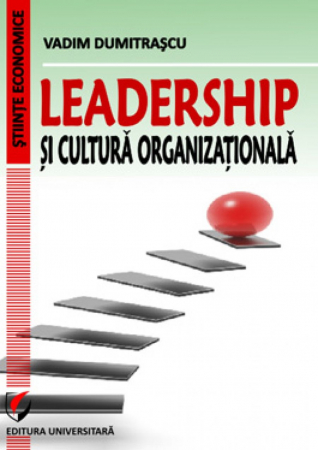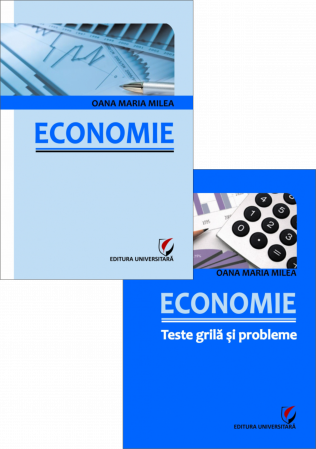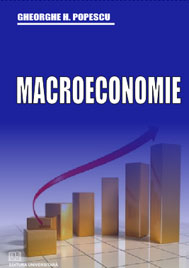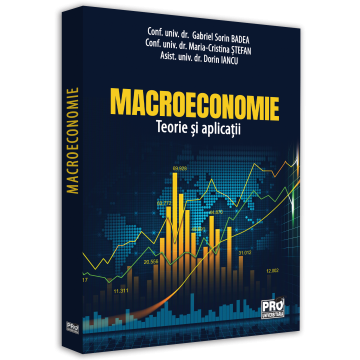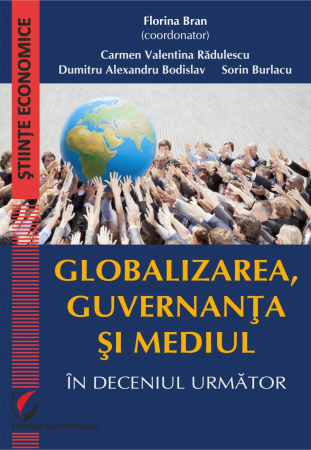Manuscript proposals: info@editurauniversitara.ro / 0745 204 115 //// Tracking orders Individuals / Sales:0745 200 718 / 0745 200 357 Orders Legal entities: 0721 722 783
ISBN: 978-606-28-0084-01
DOI: 10.5682/9786062800840
Publisher year: 2014
Pages: 144
Publisher: Editura Universitara
Author: Oana Mionel
Product Code:
97860628008401
Do you need help?
0745 200 718
/
0745 200 357
- Description
- Download (1)
- Authors
- Content
- More details
- Where to find it
- Reviews (0)
Financial markets enjoy interest in the business world insofar as they provide an organized framework for conducting transactions and a system of principles and rules that guarantee the conclusion and execution of contracts in terms of accuracy and fairness.
The work International Financial Markets is dedicated to all those who want to discover the fascinating world of the financial environment, in which you earn real money, many, but with one exception, not to lose everything in a few seconds.
The work International Financial Markets is dedicated to all those who want to discover the fascinating world of the financial environment, in which you earn real money, many, but with one exception, not to lose everything in a few seconds.
-
International Financial Markets
Download
OANA MIONEL
Doctor in economics, title awarded by the Academy of Economic Studies and, at the same time, associate professor at the Faculty of International Economic Relations within the "Dimitrie Cantemir" Christian University.
The author of this paper teaches at the mentioned faculty the subjects: Technique of international payments and financing and International stock exchanges.
Doctor in economics, title awarded by the Academy of Economic Studies and, at the same time, associate professor at the Faculty of International Economic Relations within the "Dimitrie Cantemir" Christian University.
The author of this paper teaches at the mentioned faculty the subjects: Technique of international payments and financing and International stock exchanges.
Foreword / 8
CHAPTER 1
GLOBALIZATION OF FINANCIAL MARKETS / 10
1.1. Mutations on the international financial market / 10
1.2. Vectors of economic - financial globalization / 13
1.3. European financial markets as a special entity / 18
1.3.1. European financial markets in history / 18
1.3.2. Why are European financial markets studied as a special entity? / 21
1.4. Integration of European financial markets / 23
1.4.1. Economic and monetary union and market integration / 24
1.4.2. Economic governance in economic and monetary union / 27
1.4.3. From the integration of coal and steel production to financial integration / 29
CHAPTER 2
TAXONOMY OF INTERNATIONAL FINANCIAL MARKETS / 35
2.1. The concept of international financial markets / 35
2.2. Financial instruments specific to international financial markets / 36
2.2.1. Primary tools / 36
2.2.1.1. Actions / 37
2.2.1.2. Obligations / 46
2.2.2. Derivative instruments / 51
2.2.2.1. Futures contracts / 51
2.2.2.2. Options contracts / 53
2.2.3. Synthetic tools / 54
CHAPTER 3
FINANCIAL CENTERS: GLOBAL CITIES / 57
3.1. The concept and structure of financial centers / 57
3.2. Profile of financial centers / 58
3.3. Global cities / 63
3.3.1. The concept and socio-economic importance of the city / 63
3.3.2. Criteria for the analysis of the global city / 65
3.3.3. The dimensions of the global city / 67
3.3.4. The characteristics of the global city / 70
CHAPTER 4
INTERNATIONAL FINANCIAL CENTER / 72
4.1. European Financial Centers / 72
4.1.1. London / 73
4.1.2. Frankfurt / 76
4.1.3. Zurich / 79
4.1.4. Warsaw / 80
3.2. Asian Financial Centers / 82
4.2.1. Tokyo / 82
4.2.2. Hong Kong / 86
4.3. American Financial Center: New York / 91
CHAPTER 5
FINANCIAL INTERMEDIARIES / 96
5.1. International financial institutions / 96
5.2. Storage institutions / 99
5.3. Non-depository institutions / 100
5.4. Government intermediation agencies / 104
CHAPTER 6
SUPERVISION AND REGULATION OF FINANCIAL MARKETS / 106
6.1. Supervision and regulation / 106
6.2. Securities and Exchange Commission / 107
6.3. US Federal Reserve System / 109
6.4. Bank for International Settlements / 110
6.5. European Securities and Markets Authority / 110
6.6. Financial Supervisory Authority / 112
CHAPTER 7
INVESTMENT RISKS ON THE INTERNATIONAL FINANCIAL MARKETS / 114
7.1. Investor risk / 114
7.2. Information asymmetry / 116
7.2.1. Adverse selection / 118
7.2.2. Moral hazard / 118
7.3. Investment risks / 119
7.3.1. Available information / 119
7.3.2. Transaction costs / 120
7.3.3. The cost of research reports / 120
7.3.4. Currency risk / 120
7.3.5. Liquidity risk / 121
7.4. Uncontrollable risks / 121
7.4.1. The risk of changing monetary policies / 121
7.4.2. Macroeconomic risk and political risk / 121
7.4.3. The risk of changing regulations and taxation / 122
7.4. Risks of online financial transactions / 122
CHAPTER 8
RATING AND RATING AGENCIES / 124
8.1. Importance of the rating on the financial market / 124
8.2. The scoring process / 125
8.3. Scoring scale / 126
8.4. Rating agencies / 127
8.4.1. Standard & Poor’s / 127
8.4.2. Moody’s Investors Service / 128
8.4.3. Fitch / 129
8.4.4. European Rating Agency / 130
CHAPTER 9
INVESTOR PSYCHOLOGY IN THE FINANCIAL MARKET / 132
9.1. The role of personality psychology / 132
9.2. Typology of investors / 134
9.2.1. Defender Investor / 134
9.2.2. The imitative investor / 135
9.2.3. The authoritarian investor / 135
9.3. Determinants of the success of a financial investment / 136
9.3.1. Discipline / 136
9.3.2. Approaching decisions / 137
9.3.3. "Creating" the market and emotional stability / 138
9.3.4. Information processing / 138
CHAPTER 1
GLOBALIZATION OF FINANCIAL MARKETS / 10
1.1. Mutations on the international financial market / 10
1.2. Vectors of economic - financial globalization / 13
1.3. European financial markets as a special entity / 18
1.3.1. European financial markets in history / 18
1.3.2. Why are European financial markets studied as a special entity? / 21
1.4. Integration of European financial markets / 23
1.4.1. Economic and monetary union and market integration / 24
1.4.2. Economic governance in economic and monetary union / 27
1.4.3. From the integration of coal and steel production to financial integration / 29
CHAPTER 2
TAXONOMY OF INTERNATIONAL FINANCIAL MARKETS / 35
2.1. The concept of international financial markets / 35
2.2. Financial instruments specific to international financial markets / 36
2.2.1. Primary tools / 36
2.2.1.1. Actions / 37
2.2.1.2. Obligations / 46
2.2.2. Derivative instruments / 51
2.2.2.1. Futures contracts / 51
2.2.2.2. Options contracts / 53
2.2.3. Synthetic tools / 54
CHAPTER 3
FINANCIAL CENTERS: GLOBAL CITIES / 57
3.1. The concept and structure of financial centers / 57
3.2. Profile of financial centers / 58
3.3. Global cities / 63
3.3.1. The concept and socio-economic importance of the city / 63
3.3.2. Criteria for the analysis of the global city / 65
3.3.3. The dimensions of the global city / 67
3.3.4. The characteristics of the global city / 70
CHAPTER 4
INTERNATIONAL FINANCIAL CENTER / 72
4.1. European Financial Centers / 72
4.1.1. London / 73
4.1.2. Frankfurt / 76
4.1.3. Zurich / 79
4.1.4. Warsaw / 80
3.2. Asian Financial Centers / 82
4.2.1. Tokyo / 82
4.2.2. Hong Kong / 86
4.3. American Financial Center: New York / 91
CHAPTER 5
FINANCIAL INTERMEDIARIES / 96
5.1. International financial institutions / 96
5.2. Storage institutions / 99
5.3. Non-depository institutions / 100
5.4. Government intermediation agencies / 104
CHAPTER 6
SUPERVISION AND REGULATION OF FINANCIAL MARKETS / 106
6.1. Supervision and regulation / 106
6.2. Securities and Exchange Commission / 107
6.3. US Federal Reserve System / 109
6.4. Bank for International Settlements / 110
6.5. European Securities and Markets Authority / 110
6.6. Financial Supervisory Authority / 112
CHAPTER 7
INVESTMENT RISKS ON THE INTERNATIONAL FINANCIAL MARKETS / 114
7.1. Investor risk / 114
7.2. Information asymmetry / 116
7.2.1. Adverse selection / 118
7.2.2. Moral hazard / 118
7.3. Investment risks / 119
7.3.1. Available information / 119
7.3.2. Transaction costs / 120
7.3.3. The cost of research reports / 120
7.3.4. Currency risk / 120
7.3.5. Liquidity risk / 121
7.4. Uncontrollable risks / 121
7.4.1. The risk of changing monetary policies / 121
7.4.2. Macroeconomic risk and political risk / 121
7.4.3. The risk of changing regulations and taxation / 122
7.4. Risks of online financial transactions / 122
CHAPTER 8
RATING AND RATING AGENCIES / 124
8.1. Importance of the rating on the financial market / 124
8.2. The scoring process / 125
8.3. Scoring scale / 126
8.4. Rating agencies / 127
8.4.1. Standard & Poor’s / 127
8.4.2. Moody’s Investors Service / 128
8.4.3. Fitch / 129
8.4.4. European Rating Agency / 130
CHAPTER 9
INVESTOR PSYCHOLOGY IN THE FINANCIAL MARKET / 132
9.1. The role of personality psychology / 132
9.2. Typology of investors / 134
9.2.1. Defender Investor / 134
9.2.2. The imitative investor / 135
9.2.3. The authoritarian investor / 135
9.3. Determinants of the success of a financial investment / 136
9.3.1. Discipline / 136
9.3.2. Approaching decisions / 137
9.3.3. "Creating" the market and emotional stability / 138
9.3.4. Information processing / 138
The globalization of financial markets, a phenomenon characteristic of the late twentieth century, has led to the separation of the financial economy from the real economy. The phenomenon of globalization did not occur suddenly. A series of steps were required, which, in turn, led to what we now call behavioral financial and financial innovations. Over time, the globalization of the financial environment has produced important changes, the activity of the international market being stimulated by the combination of 3D (disintermediation, deregulation, openness), technological development (real-time access to information) and financial innovation. As a result of this combination of factors, there has been a shift from a withdrawn investor behavior toward foreign assets - behavior caused by inherent country and foreign exchange risks - to a risk-oriented behavior. In fact, private investors have begun to delegate the management of their portfolios to financial institutions, through participation in collective investment schemes. This has helped to overcome barriers to risk management, and control of funds has been the goal of diversifying benefits.
Financial markets enjoy interest in the business world insofar as they provide an organized framework for conducting transactions and a system of principles and rules that guarantee the conclusion and execution of contracts in terms of accuracy and fairness.
The work International Financial Markets is dedicated to all those who want to discover the fascinating world of the financial environment, in which you earn real money, many, but with one exception, not to lose everything in a few seconds.
Financial markets enjoy interest in the business world insofar as they provide an organized framework for conducting transactions and a system of principles and rules that guarantee the conclusion and execution of contracts in terms of accuracy and fairness.
The work International Financial Markets is dedicated to all those who want to discover the fascinating world of the financial environment, in which you earn real money, many, but with one exception, not to lose everything in a few seconds.
Author
www.editurauniversitara.ro
If you want to express your opinion about this product you can add a review.
write a review
Customer Support Monday - Friday, between 8.00 - 16.00
0745 200 718 0745 200 357 comenzi@editurauniversitara.ro
6359.png)
![International Financial Markets [1] International Financial Markets [1]](https://gomagcdn.ro/domains/editurauniversitara.ro/files/product/large/piete-financiare-internationale-6442-6053.jpg)



